Blog
Archives
.
. . from 2015 to current
FRIDAY
JANUARY 31 - 2020
Elisabeth
Kinloch
The funeral of
Elisabeth Kinloch took place at Warblington Church
this morning. Pam Phillips, Jennifer Rye and myself
were present, representing the Brook Meadow
Conservation Group of which Elisabeth was an important
member in the early years of its development. Verity
Ingram from Gooseberry Cottage adjacent to Peter Pond
was also present. It was good to meet up with David
Gattrell and his daughter Emma. David has managed
Peter Pond on Elisabeth's behalf for the past 30 years
or so and we trust this arrangement will continue.
For a short appreciation of Elisabeth with some photos
go to . . . https://www.brookmeadow.org.uk/tributes/
In Lieu of flowers the
family have set up a fund to plant trees at Peter Pond
in Elisabeth's memory. David tells me they are likely
to be disease resistant Elms in the copse to the north
of the pond where there is already an abundant growth
of young Elm suckers which sadly never grow to
maturity due to Dutch Elm Disease.
If you wish to donate go to . . . http://www.justgiving.com/crowdfunding/elisabeth-kinloch
TUESDAY
JANUARY 28 - 2020
Langstone
Mill Pond
Peter
Milinets-Raby was out this morning for a short wander
around Langstone Mill Pond from 9:05am to 10:21am -
Low tide. His report follows . . .
A beautiful bright sunny morning allowing some photos
to be taken of a Great Spotted Woodpecker that was
feeding very distantly at the rear of the pond (See
photo).
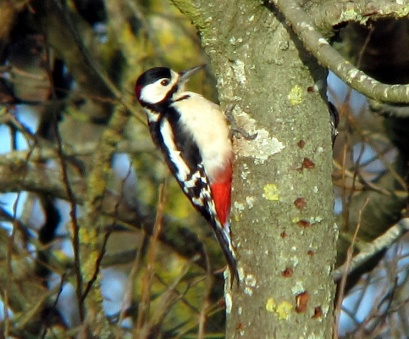
Other birds on the
pond were 12 Teal, 2 Grey Herons loitering and the
adult still sat on Nest 14. A Kingfisher dashed across
the pond, upon which were two pairs of Tufted Duck
(See photo).

A buzzard drifted over
and headed inland to the trees along Wade Lane.
Off shore there were 26 Lapwing, 118 Brent Geese, 85
Shelduck, 44 Teal and a female Red Breasted
Merganser,
MONDAY
JANUARY 27 - 2020
Garden
Blackcaps
I have news of
Blackcaps reaching our area, so keep a look out for
them in your garden. My son had a female Blackcap in
his Cowes garden on Saturday for the RSPB Birdwatch
and John Walton had both male (black cap) and female
(brown cap) in his Waterlooville garden today.
I have not seen any as
yet in my Emsworth garden. These wintering Blackcaps
come from the continent and are a quite different
population to the summer visitors from Africa that
breed here. They are particularly partial to red
apples and Victoria sponge cake!
SATURDAY
JANUARY 25 - 2020
Emsworth
Harbour
Peter
Milinets-Raby visited the Emsworth end of his patch
this morning. It was dull, very grey and cold. 8:11am
to 9:55am. Tide coming in. This was the the only bit
of colour encountered on such a dull, grey day.
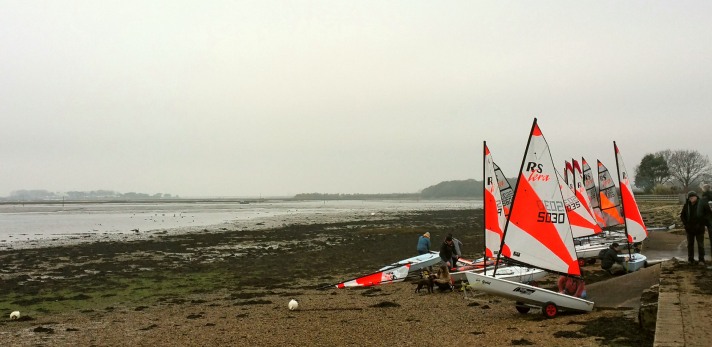
Beacon
Square:10 Grey Plover 197 Dunlin 10 Wigeon 60
Brent Geese 3 Teal 1 Shelduck
Emsworth Harbour 11 Wigeon - a new monthly
maximum, beginning to spread from Nore Barn. 9 Teal,
143 Canada Geese, 560 BrentGeese, 127 Dunlin, 1 Little
Egret, Great black-backed Gull, 9 Lapwings, 13
Shelduck, 4 Little Grebe, 2 Red breasted Mergansers, 5
Grey Plover.
On the pond were 10 Coots and a female Red
breasted Merganser showing well and close, but too
dark to get any decent photos - shame.
Nore Barn: Greenshank with rings (G//R + GL//-)
in stream on its own!!!!!??????. No Spotted Redshank.
2 Turnstone 2 Black-tailed Godwit, 4 Shelduck, 272
Brent Geese, 58 Dunlin, 4 Grey Plover, 265 Wigeon -
excellent count, just a few shy of a record. 109 Teal,
1 Grey Heron over.
Still no Pintail. This is usual the peak month, so not
looking promising. I hope this is just a blip and they
return next year? Or is this reverse global warming?
This time last year there were 33 Pintail in the area
- 20 at Nore Barn and 13 at Conigar Point.
WEDNESDAY
JANUARY 22 - 2020
Langstone
Mill Pond
Peter
Milinets-Raby had an hour visit to Langstone Mill Pond
this morning from 9:04am - tide was high, the sea as
flat as a pancake and misty!!!!

Off shore were 68
Brent Geese feeding next to the wall by the pub (See
photo) Plus 19 Teal, 39 Wigeon, 1 Great Crested Grebe,
55 Shelduck and 5 Red Breasted Mergansers.
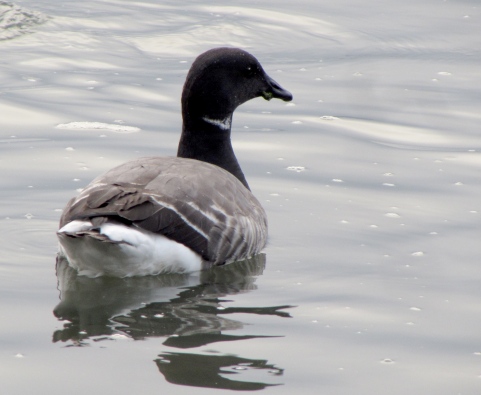
On the pond were a
pair of Tufted Duck, 15 Teal, a Kingfisher dashed from
one section to the other and the first signs of spring
. . . . A Grey Heron was sitting very tight on Nest 14
(Just its beak showing) with its mate towering above
standing on the edge of the nest. A third Grey Heron
was loitering with intent. I suspect that Nest One
must have a sitting bird as well, as they are usually
the first pair to get going!
TUESDAY
JANUARY 21 - 2020
Swan
pairs galore!
I had a walk
down to the Hermitage Millponds this morning where I
found no less than three pairs of Mute Swans,
one on Peter Pond, one on Slipper Millpond and a third
on Dolphin Lake.
Mute Swan pair on
Peter Pond
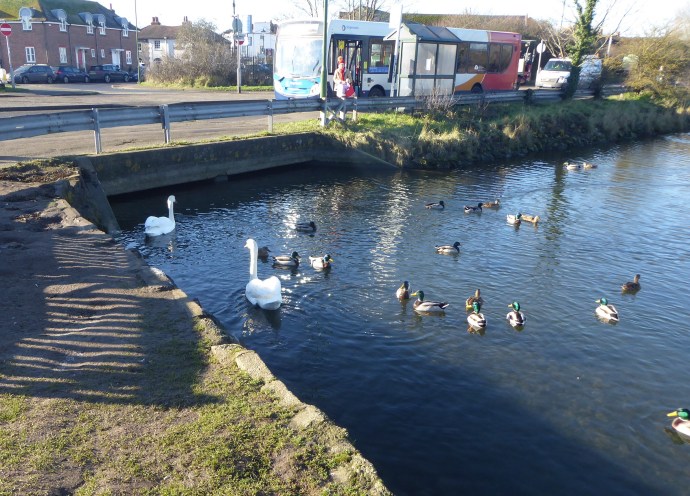
Mute Swan pair on
Slipper Millpond
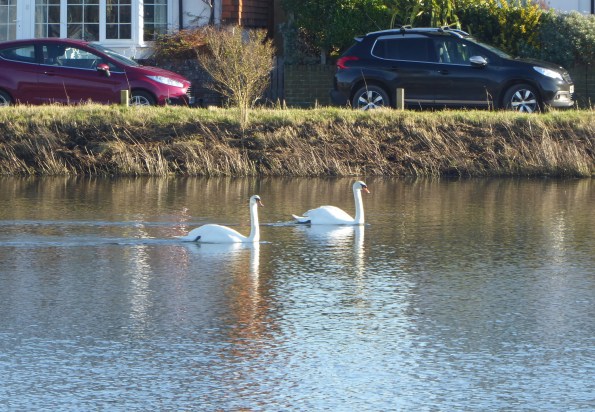
Mute Swan pair on
Dolphin Lake
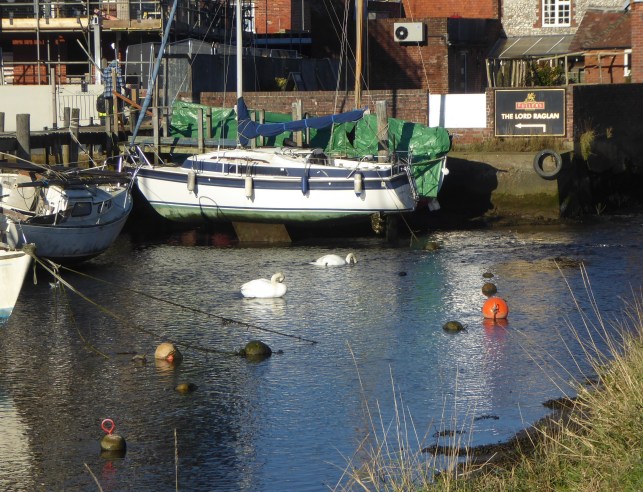
All three pairs were
swimming around peacefully while I was there, though I
suspect there will be friction between them as each
tries to establish territorial nesting rights.
The best nesting site is certainly Peter Pond where
swans have nested successfully for many years. Peter
Pond became vacant when the pen swan of the previous
owners was discovered dead last autumn. The remaining
cob stayed around for a while and we had hopes of his
finding another partner, but I believe he left, or was
driven off, by an incoming pair which now appear to be
establishing themselves on the pond. I have seen
courtship behaviour and mating in the current Peter
Pond pair so I am hopeful that this pair will settle
down to nest. One element of uncertainty concerns
whether the swans have reached breeding maturity which
is usually at age 4-5 years.
Slipper Millpond is generally not a favoured nesting
spot, though a pair of Swans has occasionally nested
in the reedbeds on the east side of the pond. It is
unusual for swans to nest on both ponds
simultaneously, though it has happened a few times in
the past. Nesting for swans on Slipper Millpond has
been extra difficult in recent years with the presence
of Great Black-backed Gulls and Canada Geese nesting
on the floating rafts. However, a determined pair
could make it happen.
As for the third pair of swans, there is no suitable
nesting site on Dolphin Lake. The nearest nesting
place would be the embankment near the entrance to
Emsworth Marina where a pair has nested successfully
in previous years, though not recently. It is
certainly not impossible that all three pairs will
nest in the area; this has happened, though not in
recent years.
Hairy
Garlic
On the way
home from Slipper Millpond I walked along the path
behind Lillywhite's Garage and was pleased to see a
fresh growth of Hairy Garlic (Allium subhirsutum) at
the eastern end of the path.
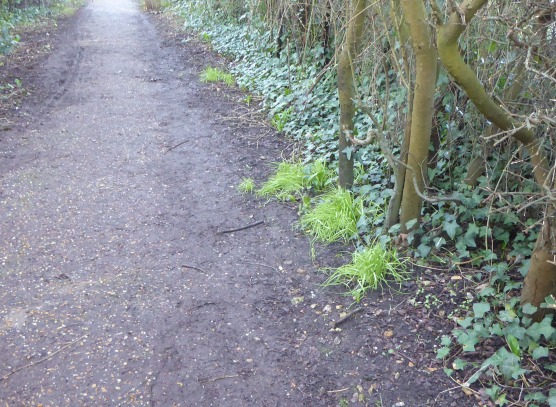
These unusual plants
have been growing at this spot for many years and can
be easily identified from the hairy leaves (from which
the plant gets its common name). These leaves give off
a faint garlic aroma when crushed.
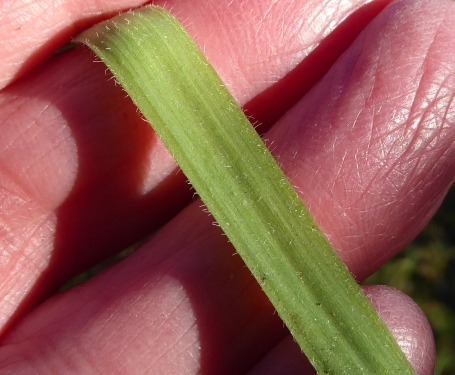
The only other Hairy
Garlic I know of in the Emsworth area are along the
path north of Nore Barn - see this blog entry for Jan
9 for photo.
Magpies
galore!
Eric Eddles
had a sight to behold opposite his house with a dozen
Magpies. The 'One for sorrow, two for joy' rhyme only
goes as far as 10. Does anyone know what 12 might be?
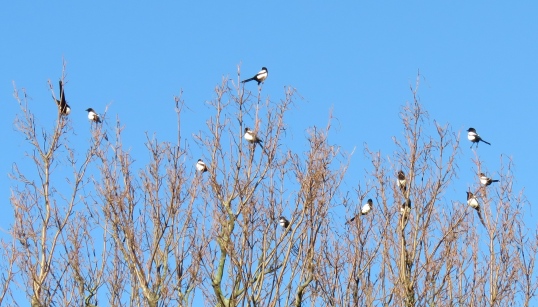
MONDAY
JANUARY 20 - 2020
Warblington
Peter
Milinets-Raby had a good wander around Warblington
this morning for a couple of hours from 9am. The tide
was going out. His report follows . . .
In the fields to the west of Castle Farm there were 14
Little Egrets, 22 Redwings, Fieldfare 5 Stock Dove, 5
Song Thrush and eventually I found just 3 Cattle
Egrets.
In the big field out to the east were 4 Brent Geese
and 5 Skylark.
In the straw dump were 5 Pied Wagtails, 2 Rock Pipits,
3 Water Pipits and 1 Meadow Pipit.
Photos of Water
Pipits
Off Conigar Point -
246 Brent Geese, 50 Shelduck, 51 Wigeon, 4 Teal, 58
Grey Plover as the tide dropped along with 593 Dunlin
and 2 Knot. 1 Great Crested Grebe. 3 Red breasted
Mergansers.
Brian's
note: Peter captured this interesting cloud formation
off Conigar Point in the morning sunshine. I think
this is a cumulonimbus front - please correct me if
not.
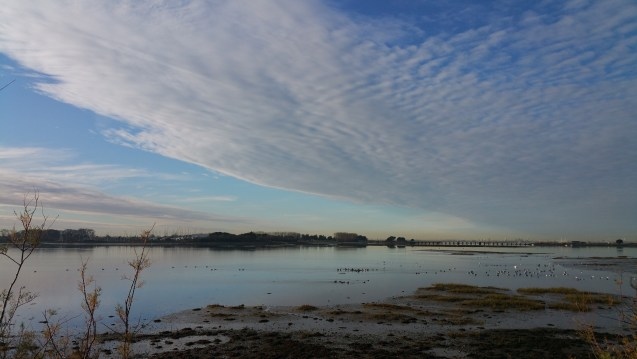
Off Pook Lane: 24
Golden Plovers, 11 Lapwings, 1 male and 2 female
Goldeneye, 1 Sparrowhawk. 2 Ravens calling softly to
one another drifted over from north Hayling and headed
north inland. 70 Dunlin, 156 Brent Geese, 37 Wigeon,
11 Grey Plover, 4 Meadow Pipits, Also I heard a
Whimbrel call - Just could not locate the culprit -
shame.
A nice clump of
Snowdrops in Warblington Cemetery.
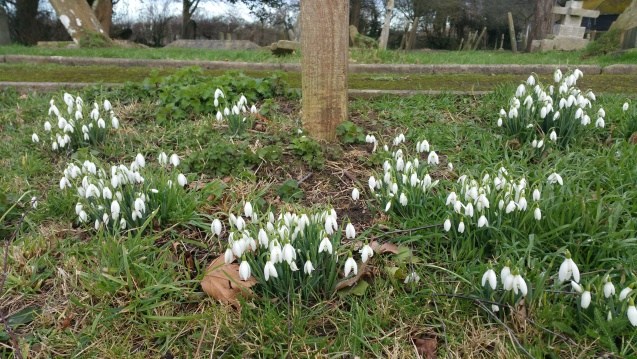
SATURDAY
JANUARY 18 - 2020
Sweet
Violets
The first
Sweet Violets are starting to flower in the usual spot
on the grass verge on the north side of Warblington
Road east of the junction with Valetta Park. Give them
a couple of weeks and they will be quite wonderful!
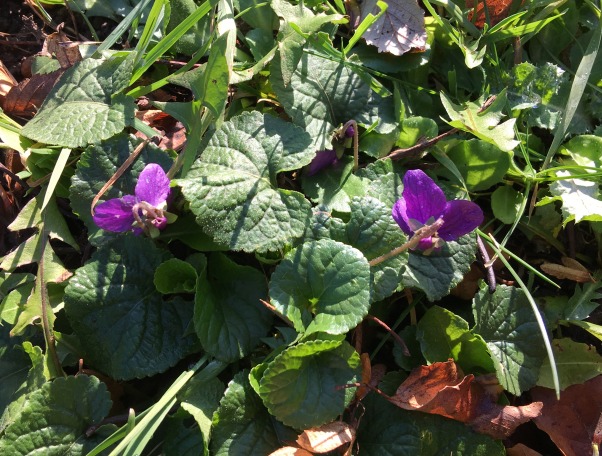
Redwing
Good to hear
that Redwing are back in the local area with the onset
of winter weather. Christopher Evans spotted this fine
fellow in the bushes alongside the horse paddock next
to the stables opposite the end of Thornham
Lane.

Stansted
Forest
Valerie
Mitchell reported on this mornings walk by the Friends
of Wildlife group
A group of 10 met at Stansted House Garden Centre car
park on a sunny, cold morning, with blue skies.

We walked along the
bridleway in front of Stansted house, then continued
up Rosamund Hill, keeping an eye out for any hares in
Hare Warren, through the woods, across the field to
Lumley Seat, along Monarch's Way and back to the
Pavilion to enjoy coffee sitting out in the sunshine
at the end of a very pleasant morning
At the beginning of the walk, we stopped to admire the
Highland cattle in the field

Everything was very
peaceful and quiet, the sun highlighting the clumps of
old man's beard at the top of the trees, the short
willow catkins and the long catkins on the hazel,
yellow in the sunshine, the very small cones on the
larch trees were well defined against the blue sky,
and the shiny white bark on the silver birches was
gleaming.
A marsh tit could be seen on the path ahead of us and
we watched it until it flew up into the tree, blue,
coal and long tails were also spotted. Green
woodpecker and Jay were heard. Whilst watching a
buzzard in the distant trees, a hare was briefly seen
disappearing at the edge of Hare Warren. Nuthatch,
tree creeper, goldcrest, wrens, robins, blackbirds,
goldfinches, jackdaws, pheasant, spotted woodpecker
and thrush were also seen.
For more information
about this wildlife group go to . . . Havant
Wildlife Group
Thorney
Island
Romney Turner
had a walk down Thorney Island as far as the sluice at
Great Deeps. She saw a female Harrier quartering the
field of reeds on the main road opposite Thornham Lane
- into the sun so not the greatest photo.
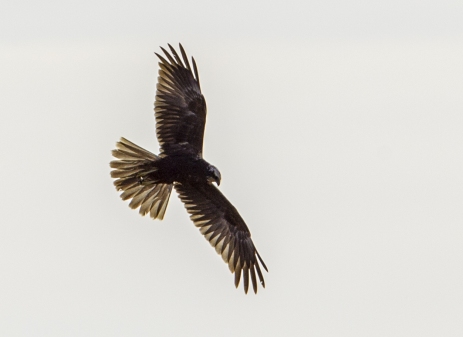
Romney also saw a male
Goldeneye on its own diving in the sea and on the way
back a collection of about 10 Tufted Ducks snoozing on
Little Deeps.
THURSDAY
JANUARY 16 - 2020
Brook
Meadow Workday
There was a
good turn out of volunteers for this morning's
conservation work session led by Reg.
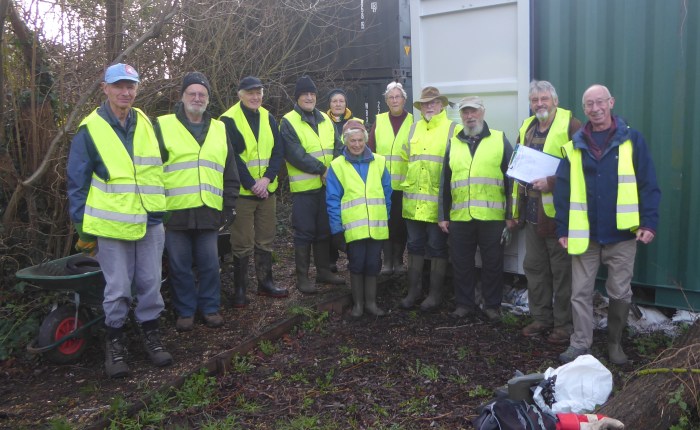
The weather was fine,
though rain was forecast and did come at the end of
the session. The main task was to cut away the
undergrowth around the small trees on the south side
of the north path

and to remove the
cuttings to the Seagull Lane patch for a future
bonfire.
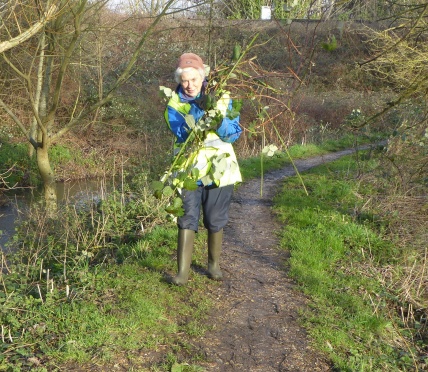
This work will benefit
the general area by giving space for the trees to grow
and small plants to flourish, as well opening up the
view of the meadow from the north path. A large area
was cleared of brambles and other undergrowth but more
work needed for completion.
For the full report
and more photos go to . . . https://www.brookmeadow.org.uk/conservation-news/
Elisabeth
Kinloch dies
Pam passed on
the news from David Gattrell that Elisabeth Kinloch
had died over the Christmas period aged 97 years! She
had been ill with dementia for many years and had been
cared for at her home in Westbourne. Elisabeth is the
owner of Peter Pond and we trust David will be able to
carry on with his excellent management of the pond.
Elisabeth was also an active member of the committee
of the Brook Meadow Conservation Group in the early
days of the group. She was also a distinguished
architect and designed the present Emsworth Surgery. I
plan to make a tribute page for Elisabeth on this web
site, so would be grateful for any appreciations and
memories from those who knew her.
Here is a nice
shot I got of Elisabeth and David together
on Peter Pond in 2008 before her illness.
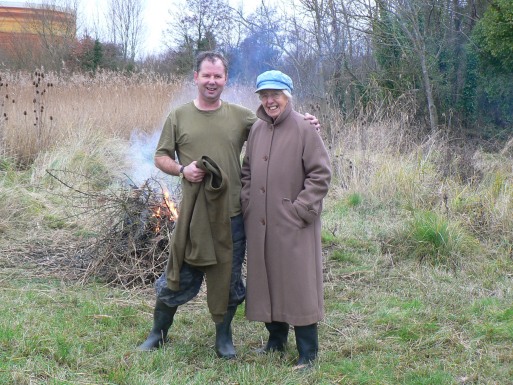
WEDNESDAY
JANUARY 15 - 2020
New
swan pair
This afternoon
I walked through Brook Meadow which was very wet after
the heavy rain; lots of small branches and twigs were
down and the south meadow flooded with the south gate
locked by the Environment Agency.
Down at Peter Pond a pair of Mute Swans were clearly
indulging in courtship behaviour with close contact,
synchronous dipping of heads into the water and at one
point and attempting to mate.


My guess is that they
are a new pair to the pond and the old cob, who lost
his mate, has departed or been driven off. Several
others including Dan Mortimer, Brendan Gibb-Gray and
Pam Phillips have reported a new pair in addition to
the old cob which was nowhere to be seen today. But
things could still change, so please keep looking!
These video clips show
the courtship behaviour and mating activity.
Courtship behaviour .
. . https://youtu.be/pQxDOK5iz8U
Mating behaviour . . .
https://youtu.be/i_LRSEwm3NI
Langstone
Mill Pond
Peter
Milinets-Raby went out at Noon and as expected, there
was nothing blown in after Brendan past through. The
tide was nearly high.
Off shore from the Langstone Mill Pond were 200+ Brent
Geese, 26 Wigeon, 4 sleeping Red Breasted Merganser
that floated inshore with the tide. They drifted close
for a half decent photo

On the last bits of
sea marsh were 28 Lapwing, 9 Redshank and 1 Greenshank
(NR//- + YY//- Seen last year in July).
On the pond were 2 male and a female Tufted Duck. Not
much else.
The flooded paddock was truly flooded after
yesterday's relentless rain (see photo via phone - the
white blobs are the egrets). Probably the most water I
have seen in seven years!!!
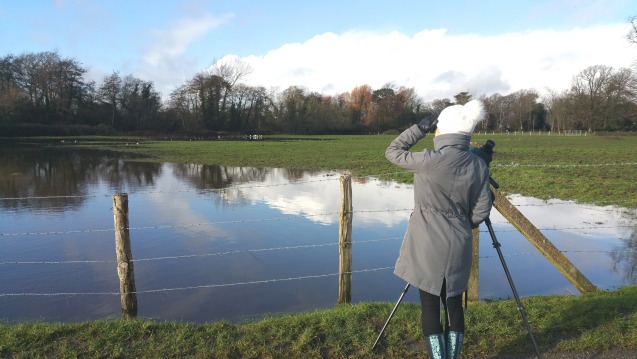
In the paddock were 2
Grey Herons, 8 Little Egrets, 98 Teal and 2
Wigeon,
Finally, as the tide pushed in I found a Great
Northern Diver in the distance off Conigar Point,
enjoying diving for crabs. Also out there was a single
Great Crested Grebe.
Red-breasted
Mergansers
Christopher
Evans reports six Red-breasted Mergansers were near
the sluice on the western side of Thorney this
afternoon. One of the males was nice and close the
females less so.

Also in the same
general area was a pair of Goldeneyes but they were
too far away for a decent photo.
MONDAY
JANUARY 13 - 2020
New
swan pair?
As I passed by
Peter Pond this morning at about 11am I was interested
to see a pair of Mute Swans feeding together near the
Hermitage Bridge. Is this a new breeding pair? There
have been hints of a new pair for a few weeks, but
this looked fairly serious! We shall need to keep an
eye on them for signs of courtship behaviour. Pam
Phillips says this "pair " have been around for a few
days and seem to be in addition to the one remaining
cob.

Pike
in River Ems
Returning home
through Brook Meadow, I stopped by the main seat to
listen to a Song Thrush belting out its loud
repetitive song from tall trees on the south meadow.
Robin, Wren, Great Tit and Woodpigeon were also
singing. Pam Phillips came by with her three dogs and
told me she had recently met three chaps in waders
fishing in the river. When she asked them what they
had caught they said a Pike and that they threw it
back! Pam explained to them the presence of Pike in
the river was not good news for our attempts to
promote the return of Water Voles, so maybe in the
future they might consider 'losing it'! Good for you
Pam. Pike are not easy to see from the river bank as
they tend to lurk without moving in the shallows at
the side of the river, waiting for their prey. Our
last definite Pike sighting with photo was 08-Aug-19.

Langstone
Mill Pond
Peter
Milinets-Raby was out for an hour this morning (from
9an) to visit Langstone Mill Pond before Brendan moved
in!!! Some early sunshine, but clouds building (see
photo).
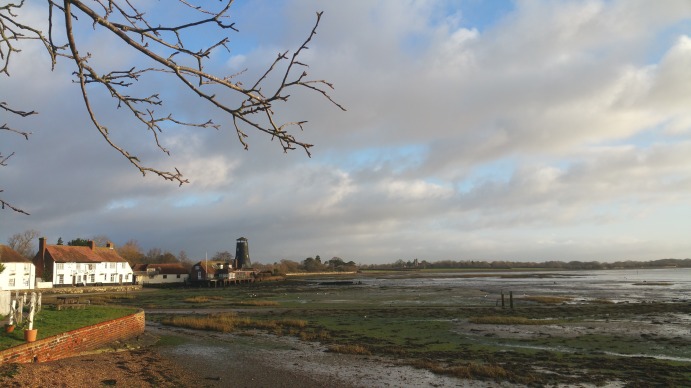
It was
low tide, but coming in. Not much to report, the
highlight being a short chat to Emily from Solent
Aware. Off shore were a single Sandwich Tern roosting
with 9 Common Gulls.
On the shoreline were 96 Shelduck, 43 Teal, 289 Brent
Geese, 25 Wigeon, 6 Lapwings and in the channel were 4
Red breasted Mergansers and a single Great Crested
Grebe. Very little. Needs to turn colder, otherwise
this will be our winter lot - nothing new to add.
And still no Pintail!!! On the pond were 2 male Tufted
Ducks with 2 females, 5 Teal and on the flooded horse
paddock a further 35 Teal and 3 Grey Herons. I wonder
if Brendan will blow in anything??
Here is a link to
Peter's excellent annual report on the past year from
Emsworth and Warblington, including his dramatic
discovery of the first breeding Cattle Egrets in
Hampshire. . . . . Peter's
Annual Report
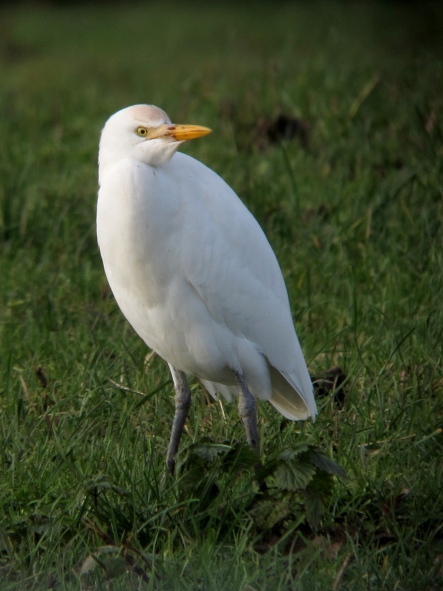
Nore
Barn history
The Friends of
Nore Barn Woods have put out a request in their recent
Newsletter for information on the history of Nore Barn
and the woods. It is known that Havant and Waterloo
Urban District Council bought the woods for £575
in 1952, but little is known about the wartime years
or how the trees arrived. And when did farming die
out? In the Newsletter Roy Ewing included this
delightful watercolour view of Nore Barn painted by H
Glanville Spooner in 1924. Thank you Roy for
permission to reproduce it here.
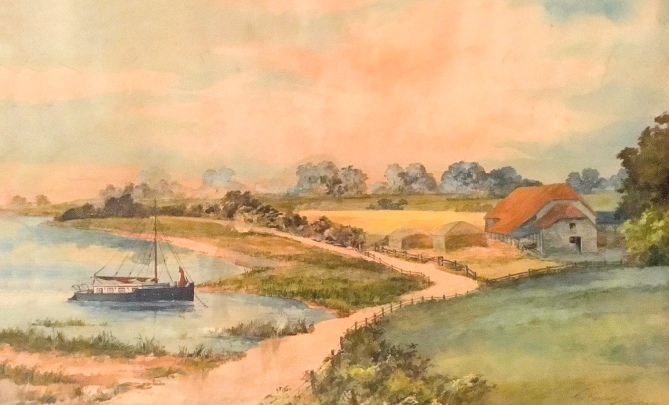
As well as the barn
the picture shows the Church Path leading to
Warblington and the main bay, saltmarshes and outlet
from the stream, which are much as they are now. The
woodland is of more recent origin. The barn does not
exist any more, but the foundations can still be
seen.
If you have any information about the history of the
woods, or anecdotes about the woods please contact Roy
Ewing at royewing1@gmail.com
Ralph's
news from Scotland
I was very
pleased to hear from Ralph Hollins with some nature
observations from his new home near Carlingwark Loch
in Castle Douglas, Scotland.
"Yesterday
(Jan 12) I was surprised to hear my first woodpecker
(presumed Great Spotted) drumming in the trees above
me as I sat on a lakeside bench watching a very smart
group of 5 Goldeneye (3 male with two females) plus
another group of 6 Dabchick nearby. Other birds in the
trees were numerous Wood Pigeons and Collared Doves
(several singing) and Jackdaws plus my first singing
Wren.
Also of note were several patches of Snowdrops coming
into flower and a couple of plants which I had first
noticed on Jan 11 of what I believe to be Spring
Sowbread (Cyclamen repandum) (page 112 of
Fitter, Fitter and Blamey's 'Wild Flowers').
It's good to see your website back on the air - I
would like to be able to contribute photos but am
still unsteady on my feet and have to use a four-wheel
'Rollator' to get around without falling over so can
only take photos when sitting on a firm seat -
hopefully I will get stronger as the spring advances."
Thanks Ralph. We
hope so too and look forward to getting more of your
observations.
No one has reported
Snowdrops down south as yet. Personally, I have never
seen Spring Sowbread here. Looking though my files I
have found a diary entry from Ralph about his finding
Sowbread on Hayling Beachlands on Monday 21
August 2017. Ralph noted at the time that this form of
Cyclamen goes under the strange name of Sowbread
because wild pigs are said to enjoy digging up and
eating the bulbs.
Here is a picture of Sowbread from the internet.
Spring Sowbread (which presumably flowers in spring)
is similar with purpler flowers and angles leaves.
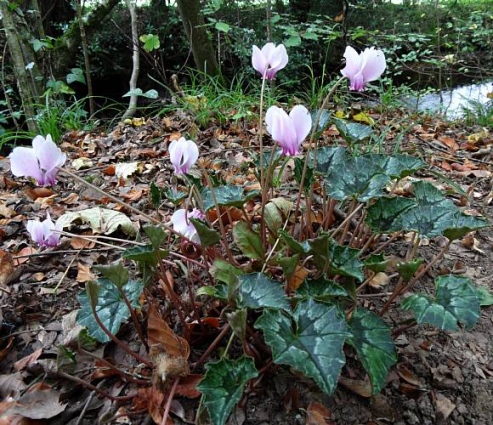
SATURDAY
JANUARY 11 - 2020
The
Kench
Valerie
Mitchell reports on this morning's walk by the Friends
of Wildlife group
Twelve of us met at the Sinah heavy anti- aircraft
battery car park on Hayling Island, it was a damp,
overcast, windy morning, and as we discussed the very
bright Wolf moon on the previous evening, a kestrel
hovered overhead.

We headed to the Kench
and followed the footpath along the shore, past Sinah
Holiday Village, until we could go no further, then
looking at the height of the high water, we decided to
retrace our steps and enjoyed walking close to the
water's edge.
At the start, we spotted 3 grey herons sheltering in
the lee of a shingle bank, thank you Derek for this
photo and others taken today.
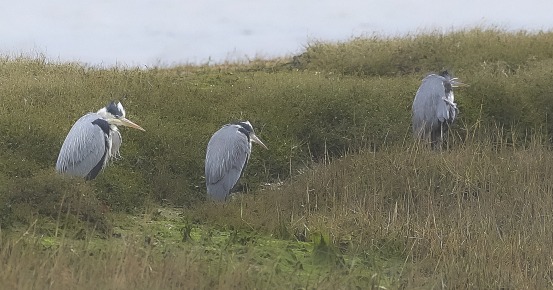
Many birds were on the
island, flocks of dunlins, oyster catchers, (looking
very smartly lined up), grey plovers, a cormorant,
egrets, redshanks, and curlew who stayed on the island
until near high tide.
Plenty of Brent geese, many gulls were flying around,
common, black headed and herring, a solitary great
black backed gull was spotted on a smaller island just
before we left the Kench.
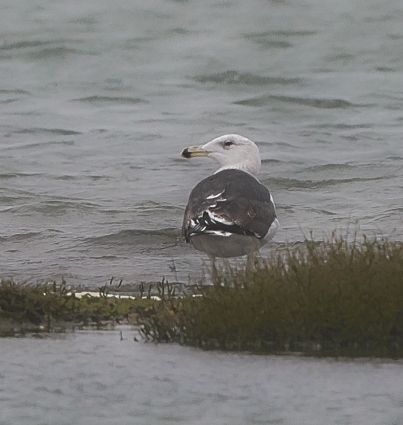
Two mergansers and a
crested grebe were seen diving around, and at coffee
time, in the far distance, Heather, using her 'scope,
spotted 2 Goldeneye, finally confirmed when she saw
their white breasts.
Just past the Sinah
Holiday Village we spotted large flocks (possibly
about 50) of redshanks and oystercatchers, they flew
up and down several times, making their lovely calls.
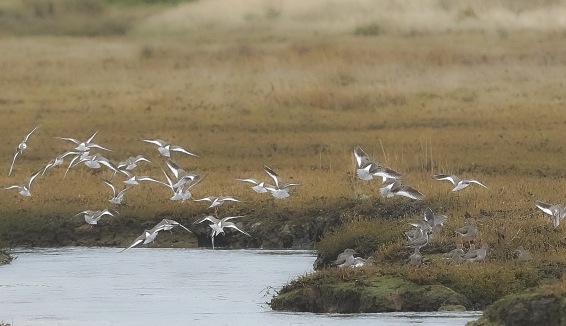
Although it rained on
our return, we arrived back at our cars having enjoyed
the walk.
For more details about
this group and their walks go to . . .
Havant
Wildlife Group
FRIDAY
JANUARY 10 - 2020
Brook
Meadow
This morning I
walked through Brook Meadow and down to Slipper
Millpond. The meadow is very wet and muddy underfoot
and the river is flowing strongly. So much rain! Not
much to report on the wildlife front. Robin and Great
Tit were singing well, but no Mistle Thrush. Wild
flowers were very scarce, but for White Dead-nettles
and the occasional Groundsel. There are plenty of
Lesser Celandine leaves (as shown in the Groundsel
photo), but no flowers as yet. However, Celandines are
out on the Westbrook Stream in Bridge Road car park.
Hazel catkins are
showing well on the tree near the north bridge
with a hint of anthers starting to emerge on the right
side catkin
Hermitage
Millponds
The lone cob
swan which lost its partner late last year was on
Peter Pond with Mallards. More significantly a new
pair of Mute Swans was on Slipper Millpond, looking as
if they intended to stay. Definitely a male-female
pair - the cob is at the rear in this photo with
Chequers Quay in the background. This could be
interesting!
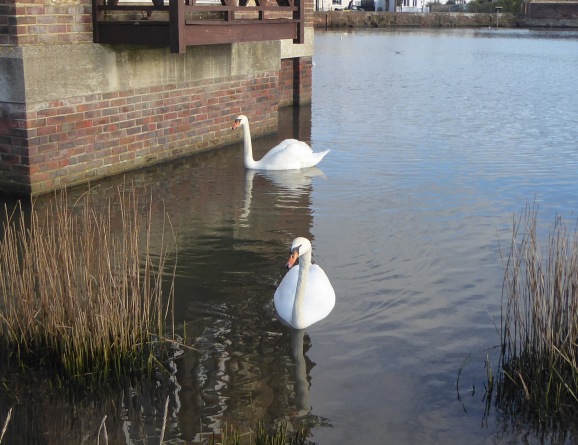
Warblington
Peter
Milinets-Raby reports on his morning's birdwatching in
the Warblington area . . .
"A bright sunny morning with two plus hours out and
around the Warblington area from 9:04am. Tide
virtually high.
14 Little Egrets with 5 Cattle Egrets in the
field west of the black barn, along with 7 Stock Doves
and a Green Woodpecker.
Off Pook Lane - tide nearly in. 48 Wigeon, 11 Teal, 29
Lapwing, 55 Grey Plover in pre-roost on the island in
the middle of Sweare Deep. 2 Great Crested Grebe, 1
Meadow Pipit, 3 Red Breasted Merganser.
Conigar Point: Female Marsh Harrier flew east
along the entire length of the channel from Hayling
Bridge to Thorney Island where it dropped quickly out
of sight. Great Views in the scope.
Straw dump: 5 Water Pipits (see
photo)
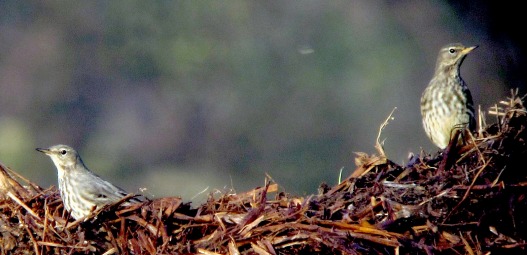
Also 2 Pied Wagtails,
2 Stock Doves, 39 Skylark in the stubble nearby, 2
Rock Pipits, 5 Meadow Pipits - causing ID problems
amongst the other pipits, 1 Buzzard and 1 Kestrel
over.
16 Brent Geese in the Winter Wheat field - four adults
with 12 juveniles - very nice".
Here is a link to
Peter's excellent annual report on the past year from
Emsworth and Warblington. You will need to download
the pdf file . . . https://peterspurplepages.wordpress.com/
Shovelers
on Baffins Pond
Eric Eddles
reports that the Shovelers have been back on Baffins
Pond for some weeks. To-day he counted 24 and posted a
photo of a small group of them feeding in their
distinctive circling fashion. Baffins Pond is
certainly the best local spot to see these attractive
birds. The photo shows two males and three females.
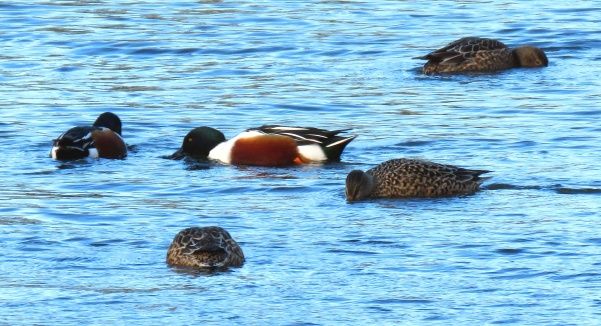
Eric also reported
60-80 Tufted Ducks plus the remaining 2 swan cygnets
of the original 7.
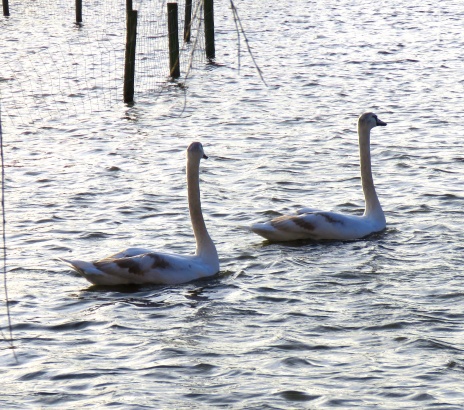
Farlington
Marshes
Romney Turner
was delighted to see some Bearded Tits while at
Farlington Marshes today. On the left below is
Romney's cracking male - and interestingly it was
ringed, presumably by the Farlington Ringing group. On
the left is a female.
Romney also saw this
fine female Marsh Harrier flying overhead - always a
nice bonus from a Farlington trip. Female Marsh
Harriers are larger and browner than their male
counterparts as it common in birds of prey. The
distinctive silvery 'palm of the hand' shows well in
Romney's photo.
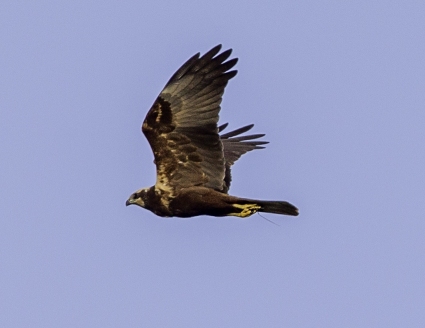
FRIDAY
JANUARY 10 - 2020
Brook
Meadow
I had a
pleasant walk this morning through Brook Meadow and
down to Slipper Millpond. The meadow is still very wet
and muddy and the river flowing strongly. Robin and
Great Tit were singing. White Dead-nettles were in
flower abundantly on the Seagull Lane patch. I found
some Groundsel in flower on the Butterbur patch near
the seat with plenty of Lesser Celandine leaves (as
shown in the photo), but no flowers as yet.
Hermitage
Millponds
The lone cob
swan which lost its partner late last year was on
Peter Pond with Mallards. But more significantly a new
pair of Mute Swans was on Slipper Millpond, looking as
if they intended to stay. Definitely a male-female
pair - the cob is at the rear in this photo with
Chequers Quay in the background. This could be
interesting!

THURSDAY
JANUARY 9 - 2020
Nore
Barn
I arrived at
Nore Barn at 11.30am with the tide still quite high.
The weather was dull and cloudy, but remarkably mild
for the time of year and the sea calm. There were few
birds on the water in the main bay apart from a small
flock of Brent Geese peacefully swimming around
and grunting gently to each other. I could only see
one juvenile, which is unusual this winter as there
have been plenty of young Brent about. They have had a
good breeding season for a change.

The regular Spotted
Redshank and colour-ringed Greenshank (G+GL) were on
edge of the saltmarshes at the far side of the stream
when I arrived.
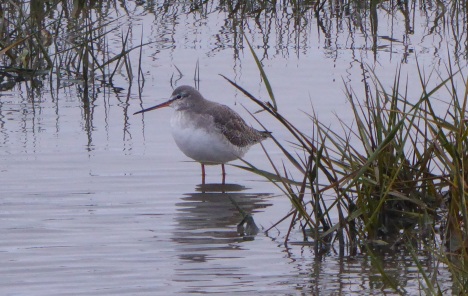
But I did not have to
wait long for them to fly onto the stream which is
their main winter feeding site. They spent the next
hour or so mostly feeding together, close to where the
fresh water stream emerges from beneath the small
bridge. While there, they provided me with wonderfully
close-up views for some photos and videos.

Video of Spotted
Redshank and Greenshank feeding . . . https://youtu.be/Sri6d7LGuvs
Video of Spotted
Redshank . . . https://youtu.be/RcGfl5KOc5o
I was the only person
to take any more than a passing interest in these
splendid birds until Roy Ewing arrived on the scene
with rake and slasher in his hands, fresh from
conservation work in the woods. He deserves a medal!
We admired the birds feeding in the stream until they
were disturbed by a dog chasing into the water and
they flew off to the saltmarshes. We gently admonished
the lady owner for not having her dog on a lead and
reminded her of the ecological importance of this
stream and the rare migrant birds that her dog had
disturbed. One can but try and hope the message gets
through. The birds actually returned to the stream
after the dog had gone as they always do, so no great
harm was done, but the principle is that wild birds
should not be disturbed when they are feeding.
For the full history
of this astonishing bird go to . . . Spotted
Redshank at Nore Barn
Hairy
Garlic
I had a walk round the woods while I was there and was
delighted to see that Hairy Garlic (Allium
subhirsutum) was still growing alongside the new
hedgerow on the north path. This plant has been
growing at this exact spot for many years and the
local conservation group are aware of it and try to
protect it. But it looks vulnerable!
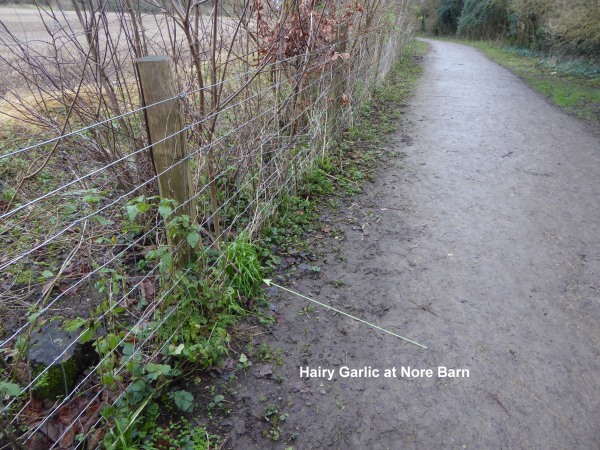
It is a rare garden
escape of Mediterranean origin. I know of only one
other site in Emsworth where it grows - on the
footpath behind Lillywhite's Garage. It has a
scattering of broad, more or less prostrate, shiny
green leaves, with slightly hairy edges, from which
the plant gets its common name. Its leaves give off a
faintly garlic aroma when crushed.
The following
photos show the plant in situ and a close-up of a leaf
with hairy edges
WEDNESDAY
JANUARY 8 - 2020
Swan
Goose goes home
I had a message from Brenda Scott this morning to say
she seen two men removing the Swan Goose from Peter
Pond and had challenged them (while still in her
pyjamas!). Brenda learned the men were the owners of
the missing bird which had escaped from Westbourne
millpond.
A little later I had a e-mail from the owner Nick Rule
to explain that he had been down to Emsworth this
morning to collect the goose - a female named Franny -
and that she was now back with the others at
Westbourne. Apparently, she had fallen over the sluice
gate at Westbourne Millpond and disappeared downriver
before Christmas. Nick thought a fox had got her and
had given up searching until he was alerted through
this blog to her presence on Peter Pond - for which he
was very grateful. Nick says he has had two others go
missing over the last couple of weeks (it is the
fighting season and testosterone is rising ready for
spring), so if anyone sees any please let him know. He
can identify them by the ring colours. Franny had a
pink ring. I will pass on any sightings to Nick.
Call
duck on Baffins Pond
Eric Eddles
writes to say that a very noisy Call Duck has been on
Baffins Pond for seven weeks.
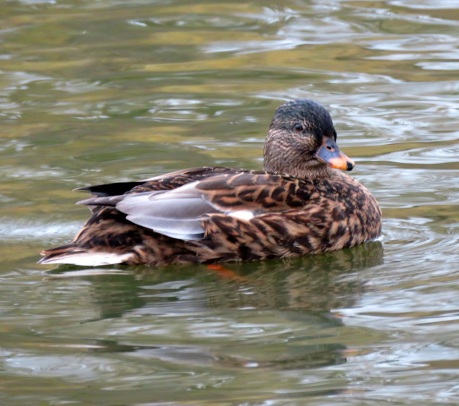
These interesting
domesticated ducks are in fact fairly common visitors
to Baffins Pond where Eric has been recording them for
several years, sometimes up to 10 in number.
The Call Duck is a very small breed of domesticated
duck now raised primarily for competition showing or
as pets. They look similar to Mallards, but are
smaller in size. They were initially used in the
Netherlands in hunting as decoys as their loud high
pitched calls would attract wild ducks towards the
hunter's guns. This practice has been replaced by
artificial calls.
TUESDAY
JANUARY 7 - 2020
Swan
Goose
The Swan Goose
(Anser cygnoides) was still present on
Peter Pond when I went down there at about 12 noon. It
was first reported to me by Pat Atkin on Jan 1. Today
it was swimming quite close to the millpond wall near
the seat, probing the wall for any bits of food. It
was making noisy honking calls as if trying to attract
attention.
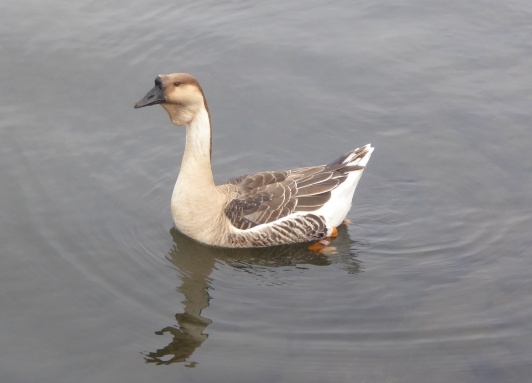
It is certainly a very
handsome bird, as noted by Maurice Lillie who happened
to be passing by at the time. I took some photos and a
video for the blog. Can you spot Maurice in the video?
Video clip of Swan
Goose . . . https://youtu.be/KVSjmncjwqU
I got a close-up of
the ring on its left leg which is made up of a series
of coils and has no markings. I wonder who it belongs
to? It must be an escape from a fairly local
collection. Does anyone have any idea where it might
be from?
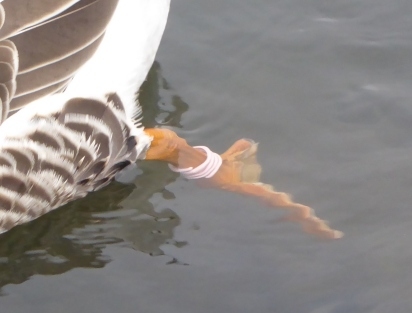
The bird's natural
breeding range is inland Mongolia, north eastern China
and south eastern Russia. It is migratory and winters
mainly in central and eastern China, though there is
no way it could fly as far as Britain! The birds we
see in Britain are escapes from domestic collections.
It is widespread in Britain.
Meanwhile, all was
quiet over on Slipper Millpond. There was no sign of
the pair of Mute Swans on Slipper Millpond that
Brendan Gibb-Gray had told me about earlier this
morning. They had probably been driven off by the
resident cob swan which was patrolling the southern
part of the pond. The cob is still wanting a partner,
having lost it long term mate a couple of months ago.
It will continue to defend its prime breeding
territory until a suitable female turns up.

Promising late
news - Brendan e-mailed this afternoon with
promising news that the cob seems to have detached one
of the pair (the female?) and they are swimming around
some distance apart with no sight of the third swan.
Could this be the beginning of a romance? It could
well be!
Interestingly, Pat
Atkin sent me the following photo he got yesterday of
the Swan Goose and the resident cob Mute Swan together
on Peter Pond. Pat said swan was closely shadowing the
goose, but appeared to be tolerating it.
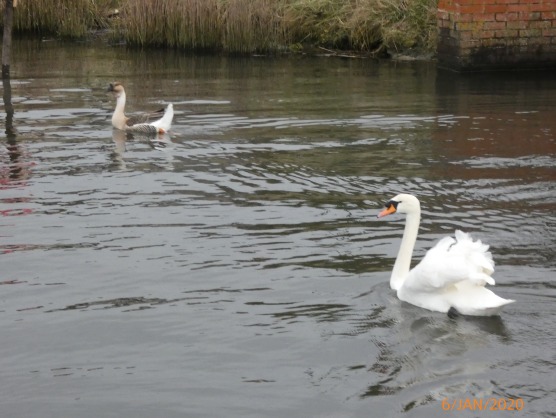
Pat also noticed this
Coot which seemed to have nest building in mind. Never
too early to start!

Warblington
Peter
Milinets-Raby had a pleasant two hours down
Warblington this morning from 9:10am. High tide -
starting to drop.
The 5 cattle Egrets were with the cattle and 9 Little
Egrets in their usual field. It was like Piccadilly
Circus today with so many birders around!
The Ibis Field held 2 Redwings.
Out at the rotting "straw" dump I had an amazing 10
Water Pipits (see photos), 1 Meadow Pipit, 1 Pied
Wagtail and 33 Skylark.
Water Pipit . . .
. Pied Wagtail
It was high tide, so
not much around.
Conigar Point: 15 Canada Geese flew east, 9 Red
breasted Merganser, 2 Great Crested Grebes, 28
Shelduck, 215 Brent Geese, 51 Wigeon.
Off Pook Lane: 2 Sandwich Tern, 46 Shelduck, 30 Grey
Plover roosting on the island in the middle of the
channel, 41 Wigeon.
The
Birds of Emsworth & Warblington 2019
Peter has
finished his annual report for The Birds of Emsworth
& Warblington 2019. It contains a very detailed
account of the first breeding of Cattle Egrets in
Hampshire.
The report can be found on Peters Purple Pages website
under the obvious heading and once there you can
download a pdf file. . . . . Go to : https://peterspurplepages.wordpress.com/
SUNDAY
JANUARY 5 - 2020
Brook
Meadow - Workday
I went over
to the meadow this morning for the first workday of
the year. The weather was cloudy and cool, ideal for
conservation work. There was a good turn out of 12
volunteers (Dan Mortimer arrived after the photo)
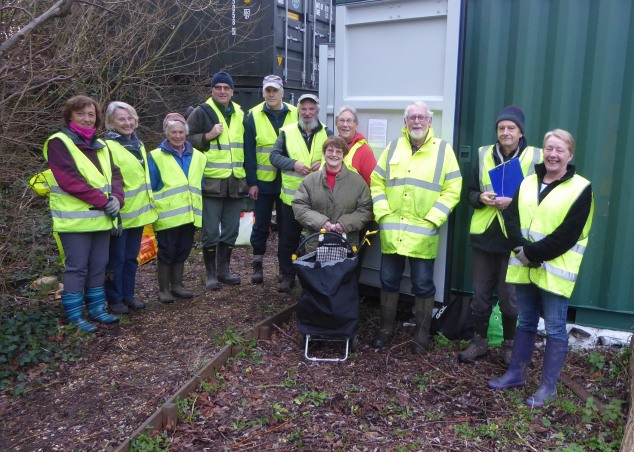
The session was led by
Colin Brotherston who outlined the main jobs for the
day.
make a bonfire
from the many tree cuttings (supervised by Debi),
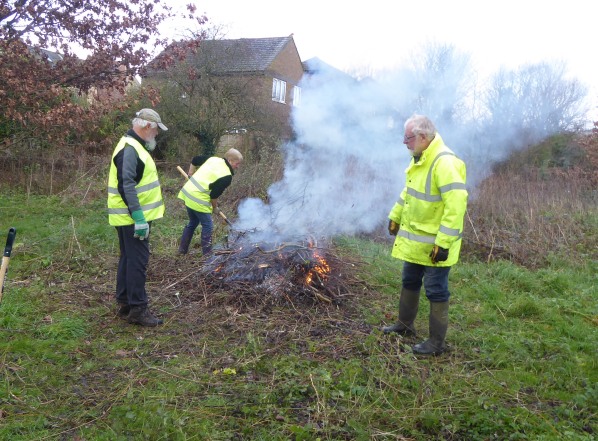
remove the tree
decorations from the Cherry trees from the Xmas school
visit
(Dianne and new volunteer Juliette)
generally tidy up the
area around the laid hedge on the centre meadow.
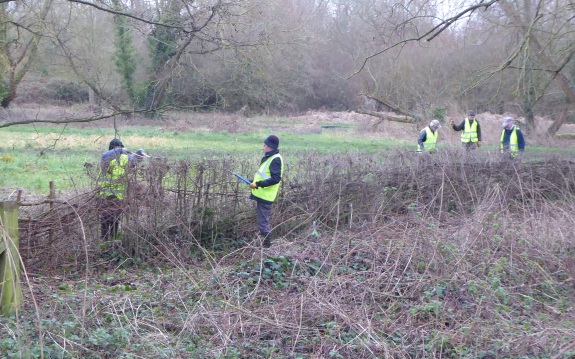
For the full report
plus more photos go to . . . https://www.brookmeadow.org.uk/conservation-news/
Wildlife
observations
Mike
discovered an attractive bright yellow small
jelly-like fungus growing on a dead twig during the
clearance. I know it as Yellow Brain Fungus
(Tremella mesenterica) though more
imaginatively it is also known as Witches
Butter. It is fairly common on dead twigs in
winter, though in dry weather it shrinks and darkens.
It is not poisonous, but is not worth eating! As with
most fungi, it is so much better to enjoy and
appreciate it in situ.
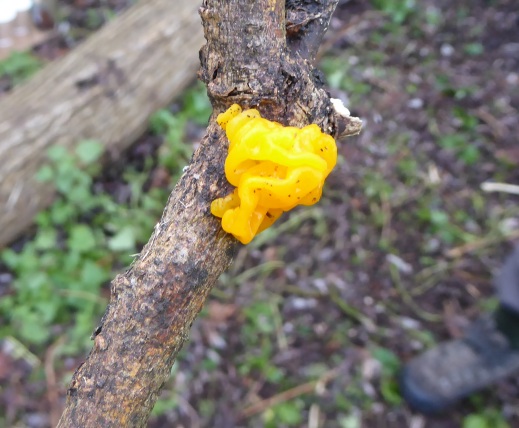
Winter Heliotrope is
now in full flower on the river bank.

A Great Tit was
singing a truncated song high in a tree
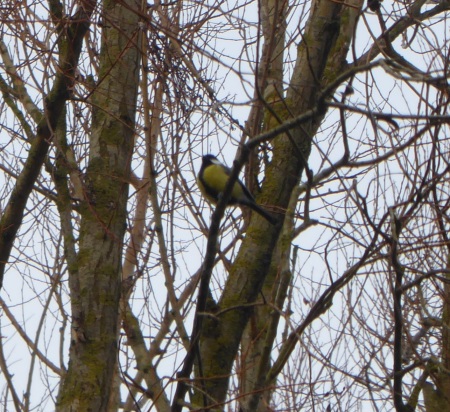 .
.
Several volunteers had
seen the mystery goose that has been hanging around
Peter Pond for the past week or so. Here is a photo of
it taken by Patrick Atkin. The bird is a Swan
Goose (Anser cygnoides) whose natural breeding
range is inland Mongolia, north eastern China and
south eastern Russia. It is migratory and winters
mainly in central and eastern China, but never flies
as far as Britain! The birds we see in
Britain are escapes from domestic collections. The
Peter Pond bird had a ring on its left leg which
clearly indicates its domestic origin. It is
widespread in Britain. Is it still around?

New
wildlife group
Helen Mears is
a member of the committee for the Havant, Hayling and
Emsworth local group of the Hampshire and IOW Wildlife
Trust and has set up a social media community group to
raise awareness of wildlife in the Havant, Hayling and
Emsworth area. She's planning to post something a
couple of times a week. Helen will use the group to
highlight local wildlife events that are happening, so
if there is anything anyone would like to share on
local wildlife then let Helen know.
The group is on Facebook, this is the link:
https://www.facebook.com/groups/580621872729183/?ref=share
SATURDAY
JANUARY 4 - 2020
Langstone
Mill Pond
Peter
Milinets-Raby spent an hour down Langstone Mill Pond
this morning from 8:11am just as the sun was rising -
a bit too cloudy for a decent sunrise shot. But not
bad!
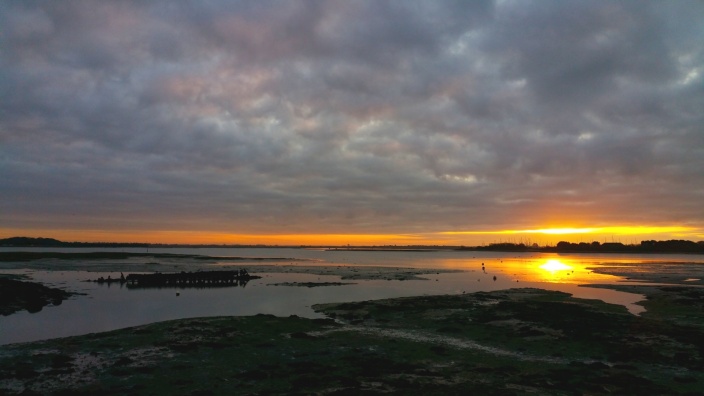
The tide was slowly
dropping. On the exposed muddy foreshore were 47 Teal,
413 Brent Geese, 13 Grey Plover, 3 Black-tailed
Godwit, 602 tightly packed feeding frenzy of Dunlin,
55 Shelduck, 12 Lapwings and 42 Wigeon. Diving in the
channel were 4 Red breasted Mergansers.
On the pond were the Mute Swan family posing for a
photo along with 7 Teal, a male, a female and a
juvenile female Tufted Duck and two Grey
Herons.
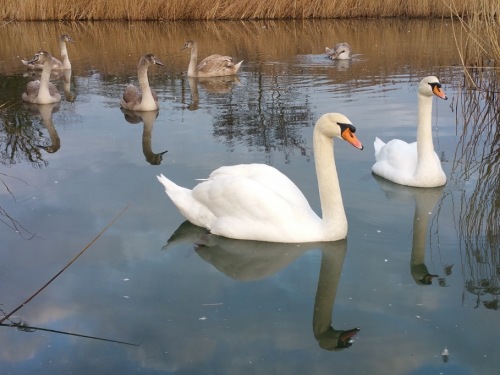
Pagham
Harbour RSPB
Nicola Hammond
reported on this morning's walk by the Friends of
Wildlife group
A
lucky group of 13 met at the RSPB Pagham car park for
a walk down to Church Norton. We stopped at the new
hide (not yet open for the day) to watch small birds
flitting around the amply filled feeders nearby and
saw a nice group of long tailed tits plus great and
blue tits.
A brief look over Ferry Pool identified Shoveler and
Wigeon. We carried on and saw a couple of redshank,
coot and moorhen in the first channel, followed by
tufted duck among a noisy group of mallard. A raptor,
possibly a harrier, was seen in the distance and a
buzzard soared above.
Unfortunately the path became too muddy to continue so
we turned round to walk back past the visitor centre
and on the path to Sidlesham Quay. More redshank were
seen plus teal, curlew and in the distance shelducks.
After coffee we returned to the hide to look out over
Ferry Pool
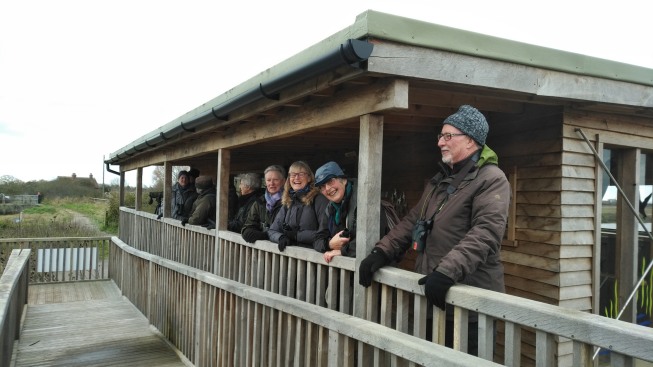
where
a large group of lapwing were in the adjoining field
and treated us to a beautiful aerial display.

There
was also a large group of wigeon in the field and on
the water were teal and mute swans.
Turning back to the bird feeders we saw chaffinches,
robins, great and blue tits, more long tailed tits and
a song thrush.
Squirrels
were busy hoovering up spillages and hanging from the
feeders, with the usual blackbirds in attendance. As
we walked back to the cars we saw three kestrels
hovering at very close quarters.
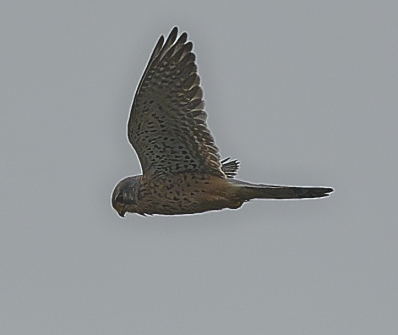
Apologies
for errors and omissions but there was a lot to catch
up on after the Christmas break, including
reminiscences of pink flamingos seen in times gone
by!
WEDNESDAY
JANUARY 1 - 2020
Emsworth
- Warblington
Peter
Milinets-Raby got the new year/decade off to an
excellent start with a fine selection of birds from
his morning walk around the Emsworth and the
Warblington areas. Here is Peter's report . . .
Emsworth Harbour from 7:40am
89 Brent Geese, 3 Wigeon, 4 Little Egrets, just 1
Greenshank, 23 Mute Swan, 9 Grey Plover, 32 Shelduck,
1 Great Crested Grebe, 87 Canada Geese, 7 Teal, 12
Turnstone, 19 Coot with 21 on Mill Pond, 175 Dunlin, 5
Lapwing, 2 Red Breasted Merganser, 1 single Knot
feeding in with the Dunlin. 1 male Goldeneye in the
channel near to the wall, 1 Little Grebe.
Beacon Square: 3 Shelduck, 2 Grey Plover, 31
Brent Geese, 16 Wigeon,
Nore Barn: 129 Wigeon, Spotted Redshank out
feeding distantly in the channel, 28 Teal, 3 Grey
Plover, 1 Turnstone. Still no Pintail??
Warblington
5 Cattle Egrets and 8 Little Egrets in the fields
north of the farm, though later they moved to their
favourite field when the cattle herd were let out
after their milking duties. 1 Redwing
Big field out to the west: 16 Skylark.
Hay dump: 13 Stock Dove, 2 Rock Pipits, 1 Water Pipit,
1 Pied Wagtail,
Conigar Point: 75 Brent Geese, 208 Dunlin, 7
Grey Plover, 6 Shelduck, 4 Red Breasted Merganser.
Pook Lane: 158 Dunlin, 9 Grey Plover, 1 Avocet
- typical, none last year! 35 Shelduck, 57 Teal, 3 Red
Breasted Merganser, 9 Lapwing, 22 Wigeon, 220 Brent
Geese, 3 Meadow Pipit.
Pat's
news
For several
years Pat Atkin has been waiting to get good pic of
Kingfisher. Yesterday, on beaching kayak at the
slipway by the Slipper Pond Apartments he spotted this
excellent male just waiting for him.
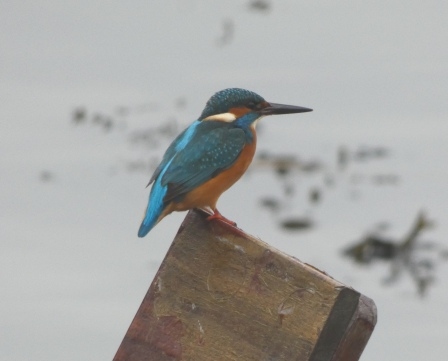
Pat also noted a
mystery goose on Peter Pond which he says has
been causing a problem in Palmer's Road Car Park. It
is certainly not a regular goose that sometimes turns
up on the ponds. It is vaguely familiar, but I can't
put a name to it.
I note it has a ring on its left leg which suggests it
may be an escaped domestic bird. Alternatively, it may
be one that David Gattrell has introduced onto Peter
Pond, so I will ask David if he knows anything about
it.

My Thanks to John
Arnott for identifying the bird as a Swan Goose
(Anser cygnoides), possibly named because its neck is
quite long for a goose. Looks like a juvenile as it
lacks the thin white stripe around the bill base. Also
known as Chinese Goose from its country of origin.
For more information see any of the following:
https://en.wikipedia.org/wiki/Swan_goose
. . . https://www.naturespot.org.uk/species/swan-goose
. . . http://www.slim-bridge.co.uk/swan%20goose.html
Pat also had a male
Red-breasted Merganser on Slipper Millpond in addition
to the regular female on the town millpond.
Garden
bird videos
I happened to
come across a couple of delightful videos of garden
birds bathing in bird baths which I thought I would
share with you. Maybe you have one of your own to
share with us?
https://youtu.be/V9MuOqTI83U
. . . This one has eight species coming to bathe in a
bird bath
https://youtu.be/J6q5msSRc6g
. . . This one is from North America and has lots of
exotic birds, including Cardinal, Blue Jay Lizards,
etc. Fascinating. Skip the ads!
For earlier reports go to . . . December
1-31